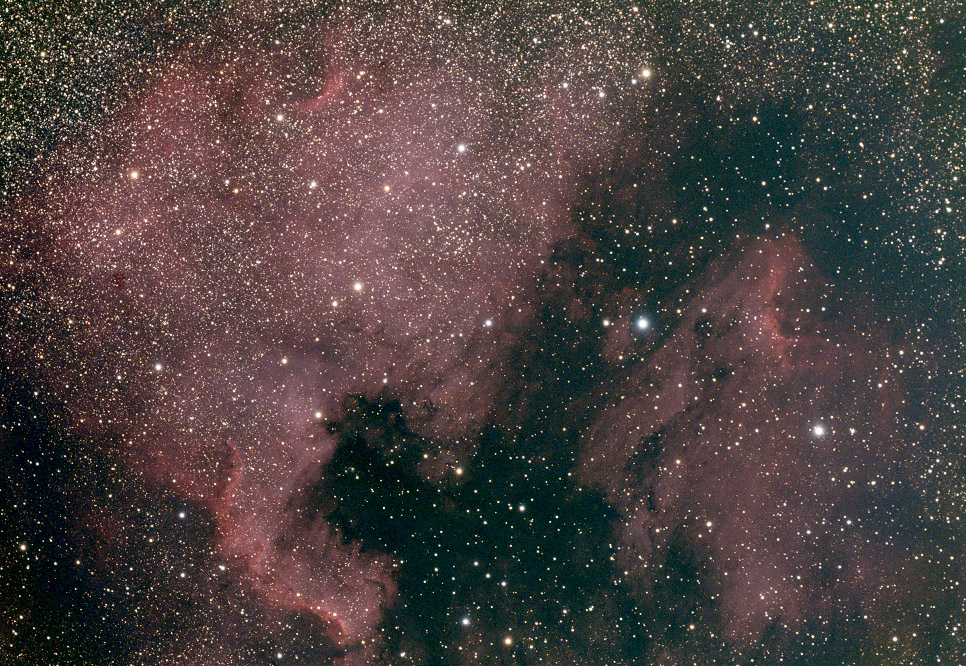2022
October
22
|
The inflation chart that you need to see
The media are reporting that we have an 8% annual inflation rate.
It is true that prices are about 8% higher than a year ago.
What they're not reporting, though, is that the increase has more or
less leveled off. Here is the chart you never see — in fact I
couldn't find it on line, so I downloaded the data and made it myself.
If suitably reminded, I'll update it in future months.
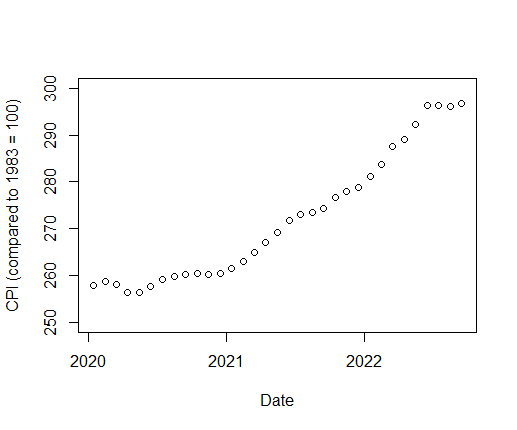
Data source: https://inflationdata.com/Inflation/Consumer_Price_Index/HistoricalCPI.aspx
Unlike most people, I don't claim to understand all that caused this
inflation or should be done about it. We've had a COVID pandemic and a
war (in Ukraine) that caused global shortages. We've also had some
government spending, possibly excessive, but on the other hand, maybe this
inflation was a deliberate trade-off against some other, worse harm, such
as mass unemployment. And we had policymakers confronting an unforeseen
situation during a time of unprecedented uncooperativeness between different
segments of society and politics.
Permanent link to this entry
Barnard's E (Field of Altair and Tarazed)
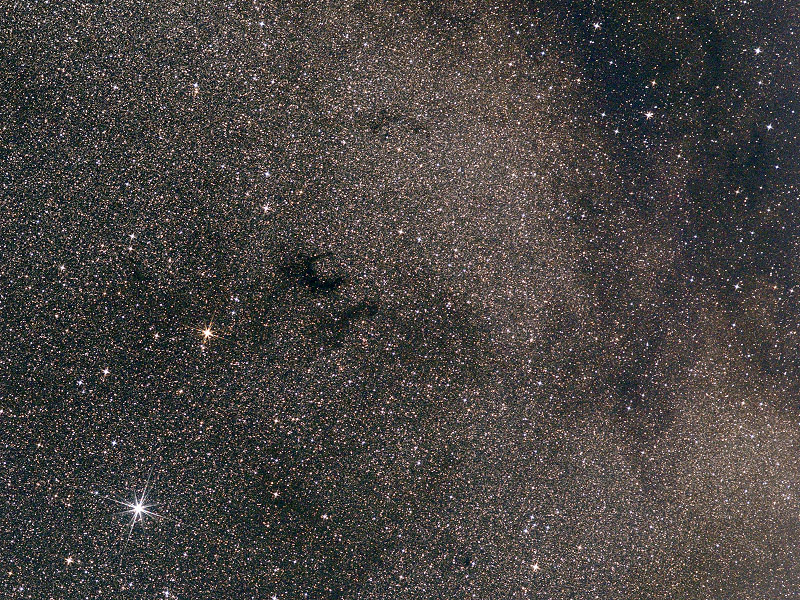
Here you see clouds of stars, and clouds of dust in front of them, in the direction
of the star Altair (at lower left). One of the dust clouds is shaped like the letter E.
This is a stack of 14 1-minute exposures with a Sigma 105-mm lens at f/4 and a
Nikon D5500 (H-alpha modified).
I took this picture last night. The occasion was that
I've been so preoccupied with iOptron and Losmandy mounts that I need to get out
some of my other gear and make sure it still works.
My ultra-portable setup, which I'll take to Deerlick if I expect it to be crowded,
is an early-model iOptron SkyTracker that runs on four AA batteries.
It has enough periodic gear error that, with a 105-mm lens on the camera,
only about 2/3 of a series of 1-minute exposures is sufficiently well tracked,
but that's enough. (In this case, I used 14 out of 21.)
The yield would be higher with 30-second exposures,
and/or with a shorter lens, and I
plan to do some more testing.
Permanent link to this entry
Jupiter
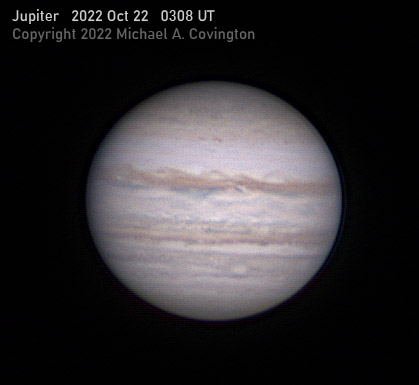
Last night I also set up the 8-inch (C8 EdgeHD) and got some good images of Jupiter,
of which this is the best. Stack of the best 25% of 3,470 video frames
(not as many as I intended to take, but I overlooked some settings).
The air was steadier at that time than later on when I refined the camera settings
and took images that I thought would be better.
Permanent link to this entry
Short notes
Let the record show that today I took a bath in the front bathroom in this house
for the first time since my wedding day in 1982.
The master bathroom is being remodeled.
At last, it will no longer be decorated with gold foil wallpaper!
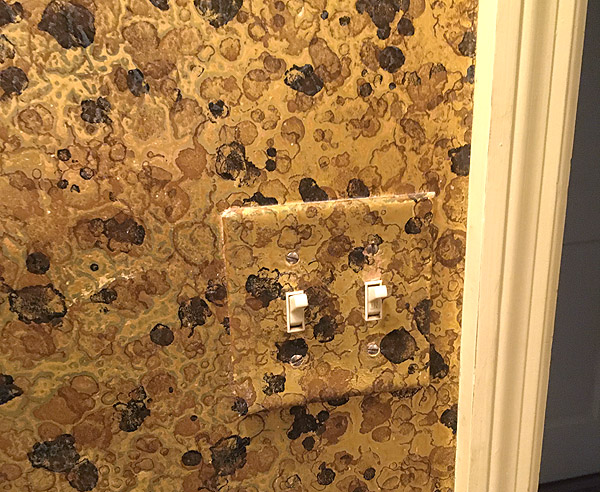
This was then my mother's house and was where I lived between finishing graduate
school and getting married.
At that time, my bedroom was in the front.
When Melody and I moved here (with daughter Cathy) after my mother died,
we took over the master bathroom in the back, and eventually the front bathroom
became Cathy and Sharon's.
In other news, I thank Melody for introducing me to the music of
Lindsey Stirling, composer and dancing violinist,
whom I had previously known only as the name attached to some nice instrumentals in our
CD and MP3 collection.
[Revised.]
Never mind the dancing and the drama or comedy, which add a lot to her videos —
the music is what I enjoy, and I am deeply
grateful that hard rock music has declined, and pleasant-sounding (but lively and creative)
instrumental music has come into its own.
In the early 1970s, instrumentals (from prominent instrumentalists, e.g., Ferrante & Teicher, Percy Faith) were usually too bland,
and rock music was, to me, too wild and noisy
and often struck me as unfinished and unpolished.
Indeed, hard rockers, just like "Modern" artists, intended to produce something the
previous generation would find unpleasant — that was part of Modernism.
(I feel some awkwardness in pointing out that "Modern" now means "50 to 120 years ago"
in the visual arts, maybe a little more recent in poetry and music.)
There was of course, instrumental music scattered through all genres, especially jazz,
but it was hard to find and was not what it is today.
Good musicians followed their instinct and talents and led us out of that era.
We went through a period of soft rock with lyrics of highly variable quality,
with some bands' instrumental work much better than their lyrics and singing.
(I think one economic factor is that
in the 1970s, many radio stations wouldn't play instrumentals; everything had to
have lyrics; so we got songs with excellent instrumental parts and shallow or
unfinished words.)
After that, thankfully, genuinely creative instrumental music flourished,
combining techniques from jazz, rock, classical music, and everything else, as well
as innovating on its own.
Some of it had always been there, of course, but hard to find and not distinct from
other genres. But I am delighted that there is now so much music of the kind I longed for, but couldn't
find much of, back in the day.
Afterthought: A big factor here, seldom mentioned, but obvious, is that
the force exerted on music by producers wanting to make popular culture
was different from the force exerted by musicians themselves.
Producers wanted to put everybody in a genre with a target market base.
Musicians wanted to follow where their talent led them.
One thing I thank Melody for is that in her younger days, she bought a lot of
albums and looked for the tracks in which the musicians were doing what they
wanted to — the tracks you never heard on the radio — the tracks that
didn't even fit the genre. That's where the good music was to be found.
Permanent link to this entry


|
2022
October
16
|
Jupiter

Another decent picture of Jupiter. Notice how small the Great Red Spot is, compared to
pictures from the 1970s or drawings from the 1890s. It has shrunk!
Best 25% of 5,879 video frames, C8 EdgeHD, 2× extender, ASI120MM-C camera,
in my driveway. The air was moderately steady. There will be better pictures,
but I'm more interested in following the action in Jupiter's atmosphere than in
getting one competitively-good picture.
Permanent link to this entry
Short notes
Let the record show that, for the first time since the COVID shutdown,
I have a UGA parking permit and to my delight,
I was able to get one for the same parking deck I've
used all those years. In the spring of 2020, during the COVID shutdown,
the University cancelled all parking permits and gave us refunds.
Meanwhile, my work routine shifted so that I usually go to the FormFree office,
and my trips to campus were so infrequent that it was better to pay by the hour
for parking. Now I'm on campus a bit more, and the year-round parking permit
is the better deal. Also, it means I won't be turned away when the deck is
nearly full.
Boom! The SpaceX Crew-4 spacecraft was predicted to fly right over us
at 4:47 p.m. on Friday, so I was out in the yard watching.
I didn't see anything, though I did see several jetliners, confirmed
with the FlightAware app. Then, at 4:50, I heard a boom. This turned out to be
its sonic boom, heard over a wide area. Apparently the spacecraft itself was
about 30 miles west of me, obscured by trees, and it took three minutes for
the sound to arrive.
Permanent link to this entry


|
2022
October
15
|
Jupiter

Here's last night's catch, a stack of the best 25% of 5,880 video frames.
Celestron 8 EdgeHD, 2× extender, ASI120MM-C camera.
This is not the best this telescope can do, but it's a decent picture
showing the state of Jupiter's atmosphere at the time.
Permanent link to this entry
Perils of imaging Saturn
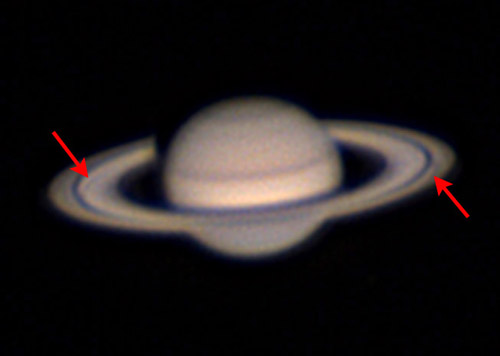
Earlier that evening, through very unsteady air, I got a picture of Saturn that shows
two curious streaks on the rings (marked with arrows).
Note that the streaks seem to be faint copies of nearby parts of Cassini's Division
(the gap between the rings).
They are very unlikely to be real. What's going on?
I started a discussion on Cloudy Nights Forums, and it was suggested that the telescope
might be out of collimation. Image stacking and sharpening methods assume a circular
point spread function, and miscollimation can make them produce strange results.
But I got the telescope out again tonight, and it's in perfect collimation.
So I'll have to blame the unsteady air. Watching the video, I see that the rings
on each side of Saturn seemed to flap up and down like wings, the air was so
unsteady, and apparently some of the distortions repeated themselves enough to
get aligned as if they were real features in the image.
Permanent link to this entry
I tip people but not companies
Although I don't think tipping is a very fair system to pay waiters, taxi drivers, etc., for their work,
I tip generously where it is customary, since people are depending on it for their livelihood.
But I balk at "adding a tip" at a totally self-service business, such as a restaurant we
dined at this evening. Maybe the tip is "for the counter staff" but there's no clear indication
of who gets it. It looks to me like the company wants us to volunteer to pay a higher price
than the advertised one. And that is not fair dealing.
It almost sounds like a declaration that the hourly employees aren't paid adequately.
Is that something to be proud of?
[Added:] I have in mind primarily not tip jars, which are purely
voluntary, but tip amounts popping up as automatically added on credit card terminals.
You can decline them, and if there is no waiter or person providing individual service,
that's what I do. I don't think someone earns 15% of the cost of my dinner by simply
punching the order into the cash register.
My deeper concern is that our economy gets its efficiency from clear asking prices.
Some cultures expect people to negotiate
almost every price downward; that is less efficient. Think what chaos it would be it the expectation were to
arise that the customer would raise the price. When you buy a car, how much
do you tip the salesman?
Permanent link to this entry


|
2022
October
12-15
|
Windows 11 and the Start Menu
[REVISED.]
If you are switching from Windows 10 to 11, and you have your Start Menu organized
into groups of apps, write down the grouping before you switch.
The reason is, you are going to lose it and have to re-create it.
As of Windows 11 22H2, there is no longer a registry setting that brings
back the old, hierarchical Start Menu. Instead, as on an iPhone, you can put
pinned apps into folders (which you can name) by dragging them on top of each
other — but the structure you had under Windows 10 isn't preserved.
For more about Start Menu organization in Windows 11, see this:
https://beebom.com/how-create-app-folders-windows-11-start-menu/.
Here's how I recommend approaching the conversion:
(1) In Windows 10, write down what your pinned apps are, and what groups you have them in.
For instance, here is part of what I had:
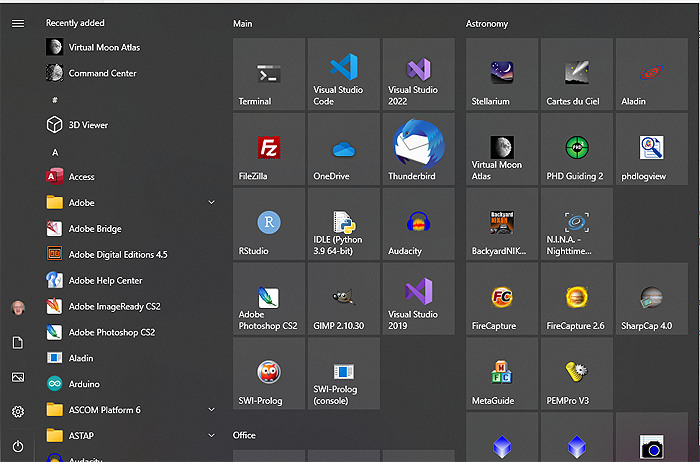
All told, I had 54 pinned apps in 8 groups. I know I'm a power user, but I do a lot of
things with this computer!
(2) Install Windows 11.
(3) Open your Start Menu. Right-click anywhere in it, go to Start Settings, and choose More Pinned
(to have more room for pinned apps).
(4) You'll see you already have a lot of pinned apps, more or less in random order.
Many are entertainment things you don't need (e.g., I don't use Instagram).
Either right-click on each unwanted app and unpin it (which does not remove it from
your computer), or make a "Misc" folder of apps you rarely or never use.
Recall that a folder is created by dragging an app on top of another app.
When you open the folder, you can edit its name.
(5) Go through the "All Apps" menu and right-click and Pin to Start all the apps you
are going to want to have in your Start Menu (whether singly or in folders).
(6) Arrange them into folders. Here's what I have right now, though it's subject
to adjustment:
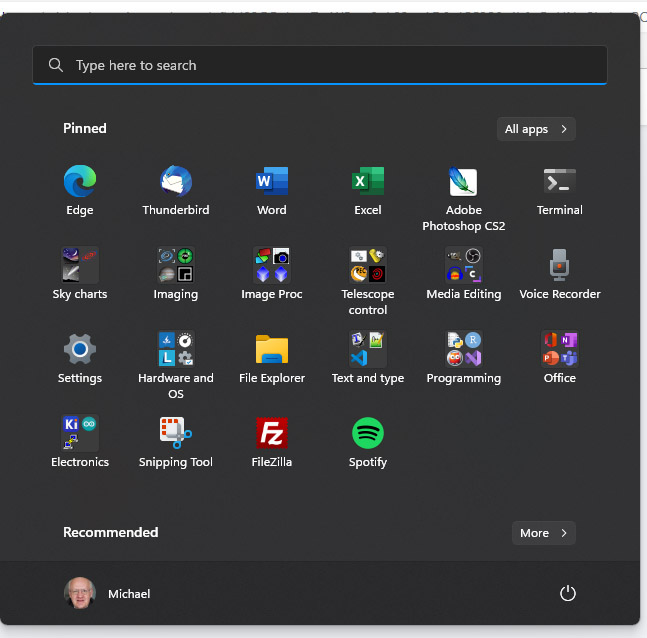
There. Windows 11 is livable.
More about Windows 11:
The biggest change is that when you right-click on a file, you don't see such a big menu.
Instead, the menu has "Show more options" at the bottom, and that gives you everything
else that was on the Windows 10 right-click menu. I have quite a few utilities that can
apply to almost any file and are accessed that way. I'm not sure whether I think the
two-step process is an improvement.
Another difference is that (without third-party software) you no longer have a registry option
to display the time of day in seconds, not just minutes on the taskbar.
The reason is surprising, but makes sense.
Screen activity more frequent than once per minute keeps the computer "awake" and prevents
going into low-power mode. So Microsoft took away that option.
Does Windows 10 software work in Windows 11?
Yes, of course; it doesn't even know it's running under 11; the version number
of Windows 11 22H2 is 10.0.22621.674.
Permanent link to this entry
The weather on Jupiter
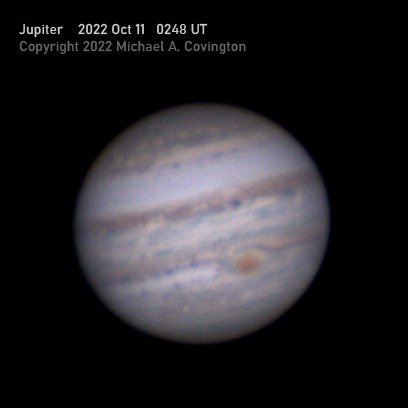
This image of Jupiter was taken in unsteady air and isn't very good, but it shows two big
things that are happening on Jupiter: the Great Red Spot is very small (it has been shrinking
throughout my lifetime), and the North Temperate Zone is blank.
Permanent link to this entry
Misfeature of the day
Word has reached me of a home weather radio that sounds its alarm,
not only for weather alerts, but also for Amber Alerts.
Somebody didn't think that through. Lost or kidnapped children are not going to
be wandering through people's houses in the middle of the night.
I want you to wake me up for a tornado — not for a kidnapping 150 miles away.
I know they want to show they care, but this is a case of "I want to show my feelings" got ahead of
"I want to actually do somebody some good."
Permanent link to this entry


|
2022
October
9
|
Jupiter and Europa
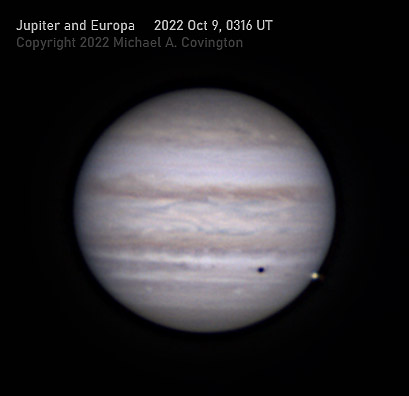
Here's last night's catch. Jupiter's satellite Europa has just passed across the face
of the planet, and its shadow is still on it. The air was unsteady, but by stacking just
the best 25% of 6,800 video frames, I got a decent image. Celestron 8 EdgeHD telescope, in my driveway.
Permanent link to this entry
No eyes and no apples: A misconceived riddle
I am blogging about this so that people who Google the answer to the riddle
will, perhaps, find this explanation.
All too often, the supposedly correct answer to a riddle or even a
mathematical puzzle is somebody pompously telling
you something that's unreasonable or even false.
Here's an example. The following riddle is going around the Internet:
A man with no eyes sees apples on a tree.
He takes no apples but leaves no apples. How can this be?
The answer is supposed to be that he has one eye and takes one of two apples (leaving one).
We're told that one eye is not "eyes" and one apple is not "apples."
I call foul. In English, "no eyes" means not even one eye, and "no apples" means
not even one apple. Everybody who speaks our language knows this.
No amount of pompous lecturing will change it.
The riddle has a chance of making sense if you tell it this way:
A man who does not have eyes sees apples on a tree.
He does not take apples but he does not leave apples. How can this be?
"Doesn't have eyes" can indeed mean "has one eye but not more than one."
("I don't own houses; I own one house.") That is not its main interpretation,
but it is a possible one. It works better than "no eyes." The same goes for
"doesn't take/leave apples."
Permanent link to this entry
Lizard
|
| |
The other day Melody, who is an artist, remarked on something about the style of my
astronomical photographs, including the one from last month that is repeated above.
She said they have a quality of transparency or naturalness that other people's astrophotos
often lack.
It took both of us some time to figure out exactly what this meant.
The essence of it, I think, is that the image processing is done with a somewhat
light hand. My goal, in each picture, is to show you what's in it,
not just make a vivid impression.
That is, I am not primarily doing "space art."
Some people are drawn to astrophotography because it gives them the opportunity to produce,
photographically and in real life, something like what science-fiction fantasy painters paint —
very dramatic images of exotic parts of the universe.
That's a valid thing to do, but it's not what I'm doing.
My goal is a bit different.
Drawing on a tradition of scientific astrophotography, I want to
photograph an area of sky and show you what is there.
I process the images to reveal what the camera has captured,
and seldom to emphasize something so much that something else is lost.
Also, I am seldom working right at the limits of my equipment, and this
gives the pictures a more relaxed quality than you will see in more
competitive astrophotography.
When explaining this to other astrophotographers I made the mistake of citing
Ansel Adams as a photographer whose work I admire and have learned from.
"Adams' pictures are very heavily processed," they retorted.
No, they're not. They are well controlled.
Adams controlled exposure and dynamic range.
I know some of his pictures, such as "Moonrise," look rather different
from what the eye would have seen.
But his pictures depict. He made the camera capture the dynamic range
of the subject, and then he made the enlarger render it on paper.
His goal was to show you what was there.
I suspect some of Adams' critics don't realize he was just controlling more
precisely the processing that is always performed by the camera,
film, enlarger, and paper. There is no such thing as an unprocessed digital
image (terrestrial or astronomical), for the same reason there is nothing to
see on undeveloped film.
Permanent link to this entry


|
2022
October
5
|
Sweet Sixteen times four

What's four times as sweet as Sweet Sixteen? Sweet 64, of course!
I want to wish Melody a happy birthday.
She says she's proud to let me mention her age, because by now, she's
proud of having reached it, considering the number of serious health problems
that have been taking shots at her for more than twenty years.
And I am glad to have her! There is none like the extraordinary Melody Mauldin!
Permanent link to this entry
Short notes
There have been no Notebook entries for several days, and this one is late uploading,
because we're all recovering from bronchitis, which nagged at me for two months before
finally flaring up. This is the third year in a row I've had a long-lasting cough that
went away suddenly when I was finally given azithromycin. Have I really been getting
mycoplasma every year, or what?
We have much to be thankful for. Results from Sharon's shoulder surgery continue to be
good, and she's getting ready to start physical therapy. My colleagues at FormFree are
joining me in making exciting research discoveries. There's never a dull moment!
Permanent link to this entry


|
|
|
This is a private web page,
not hosted or sponsored by the University of Georgia.
Copyright 2022 Michael A. Covington.
Caching by search engines is permitted.
To go to the latest entry every day, bookmark
https://www.covingtoninnovations.com/michael/blog/Default.asp
and if you get the previous month, tell your browser to refresh.
Portrait at top of page by Sharon Covington.
This web site has never collected personal information
and is not affected by GDPR.
Google Ads may use cookies to manage the rotation of ads,
but those cookies are not made available to Covington Innovations.
No personal information is collected or stored by Covington Innovations, and never has been.
This web site is based and served entirely in the United States.
In compliance with U.S. FTC guidelines,
I am glad to point out that unless explicitly
indicated, I do not receive substantial payments, free merchandise, or other remuneration
for reviewing or mentioning products on this web site.
Any remuneration valued at more than about $10 will always be mentioned here,
and in any case my writing about products and dealers is always truthful.
Reviewed
products are usually things I purchased for my own use, or occasionally items
lent to me briefly by manufacturers and described as such.
I am no longer an Amazon Associate, and links to Amazon
no longer pay me a commission for purchases,
even if they still have my code in them.
|
|
















